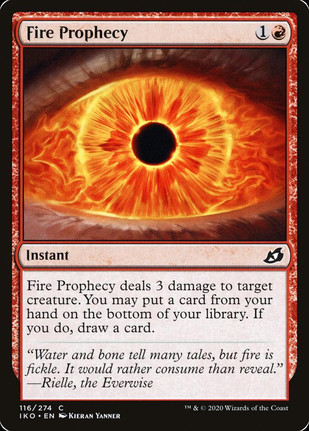Deck of the Week: Pioneer Izzet Creativity
- Connor Kirkwood
- Feb 22, 2023
- 5 min read
Updated: Aug 23, 2023

Reid Duke is your Pro Tour Phyrexia Champion, piloting Izzet Creativity all the way to first place! While this deck may not look like it, Creativity is most likely the closest thing that Pioneer will ever get to Splinter Twin, except instead of dying to a million Deceiver Exarchs, you die to an enormous Wurm.
Even though Creativity was not his first choice for the Pro Tour, Duke played this deck like an absolute master, performing a reverse sweep in the quarterfinals against World Champion Nathan Steuer and going 3-0 in the finals match against Benton Madsen. Creativity may look like a straightforward deck, but there is a lot to it that enabled it to win the Pro Tour. Let’s take a look at what makes this deck such a powerhouse.
The Combo
Let’s jump right into it by looking at the combo itself, powered by Indomitable Creativity. Izzet Creativity has only two creatures in the deck: Worldspine Wurm and Xenagos, God of Revels. The deck aims to control the game until it can get a couple of tokens on the board before casting Indomitable Creativity on those tokens and finding your two creatures, which enter the battlefield and immediately attack for 30.

The flexibility of the combo is where the deck gets its power from, and we got to see this in action in many of Reid Duke’s games. Creativity runs two Hullbreaker Horrors in the sideboard, which allows the deck to switch from a combo shell to a control shell, vastly changing how the deck functions.
When Duke performed the reverse sweep in the quarterfinals against Steuer, we got to witness Duke switch back and forth between the combo and the control shell, preventing Steuer from sideboarding effectively and allowing Duke to combo off in games four and five without interference.
Enabling the Combo
In order to combo off, Indomitable Creativity needs some creatures or artifacts to destroy. Since the deck doesn’t run any creatures other than its finishers, it must create creature and artifact tokens to be destroyed. The key cards that provide this are Fable of the Mirror Breaker and Big Score.
Fable of the Mirror Breaker does so much for this deck that it probably is the most essential card in it, other than the combo pieces. Not only does it create two creatures, but one of the creatures can make you additional treasure tokens that can be used in the combo, and Fable also lets you dig through your deck to find your Creativities. Big Score has a similar function to Fable, allowing you to create two treasure tokens at instant speed and dig through your deck.
Although these are the main ways to create tokens, there are many other ways that the deck can produce tokens. Creativity runs a single copy of Secrets of the Key and Shark Typhoon, which both can create a token at instant speed. There is also a couple of Mutavaults and Sokenzan, Crucible of Defiance, which allows you to use your lands to create targets for Creativity when you flood out.
Protecting the combo
Just like with Splinter Twin, Creativity is a blue-red-based deck, meaning that it can run a plethora of counterspells and burn spells to help get itself to its combo finish. The main deck runs only four counterspells, one Spell Pierce and three Make Disappear, which do an efficient job at protecting the combo in game one.
When playing against a deck with a lot of disruption, whether that’s counterspells or removal, Creativity runs an additional four counterspells in the sideboard, with one Mystical Dispute and Disdainful Stroke and two Negates. It also runs additional ‘pseudo-counterspells’ such as Aether Gust and Narset’s Reversal, which return your opponent’s spells to their hand and clear the way for your combo to run its course.
In order to protect against aggro decks or taxing decks, Creativity runs four Fiery Impulse, two Spikefield Hazard, and four Fire Prophecy. These allow you to get rid of aggressive creatures that are trying to end the game quickly, as well as your opponent’s Thalia, Guardian of Thraben, which might hinder your combo.
Finding the combo
When Reid Duke played against Nathan Steuer in the quarterfinals, Nathan played Lotus Field Combo, another combo deck that is very difficult to interact with. However, in games four and five, we got to see that while Lotus Field Combo is very powerful, it also has a more challenging time locating its combo pieces, meaning that sometimes the deck has to rely on top decking for the combo to go off. This is not the case for Creativity.
Creativity runs many spells that allow you to enable your combo while at the same time finding your combo pieces, as mentioned earlier with Fable of the Mirrorbreaker and Big Score. Alongside those spells, the deck gets to run four Impulses and a Dig Through Time, which both let you see many cards from your deck to find what you are missing.
Many combo decks like Creativity suffer because they rely on your combo cards being in your deck instead of in your hand. Let’s say you have tokens and an Indomitable Creativity in your hand, but you accidentally draw your Xenagos and Worldspine Wurm. This is where cards like Valakut Awakening and Fire Prophecy come in handy.
Valakut Awakening allows you to put your Xenagos and Worldspine Wurm on the bottom of your library, safely away from your draw spells and then lets you draw cards, hopefully finding more combo pieces. Fire Prophecy serves a similar function: removing a creature, putting a combo piece back into your deck, and drawing a new card. This allows the deck to smooth out its draws and ensures your combo can go off without a problem.
Who should play this deck?
This is an interesting question for this deck because a lot of people may enjoy this deck style. I try to avoid combo decks, as they are not the type of gameplay I usually enjoy. However, I was able to build a version of this in Explorer with the new Atraxa (which can be found here), and I have been enjoying the deck immensely.
The reason I usually don’t enjoy combo decks is that I don’t like the feeling of having your combo stopped and then spending the rest of the game top-decking, hoping that you can squeak out a win somehow. I also enjoy an interactive game, which, most of the time, combo decks do not provide.
However, that is not the case with this deck. While some games you get the combo and just win, many games are very interactive, and sometimes you don’t even rely on the combo. Sometimes you go for the combo and they counter it or remove your creature, but it doesn’t feel like you’ve lost. There is so much more to this deck than the combo, which is why many people may enjoy playing it.
Regarding skill level, a certain level of experience is required to play this deck efficiently. You could hand this to a new player and tell them to get out a token and then target it with Indomitable Creativity, but there are so many lines with this deck that it is really not that simple. You need to understand when you should be on offense or defense and when you should be the combo or control player, and also when you should abandon the combo entirely and rely on your Reflections of Kiki-Jiki to end the game.
I recommend this deck to any player with a high skill level and looking to play at high-level tournaments. This deck can be a lot of fun, and in the hands of a master, it can perform at the highest levels of competition. I ESPECIALLY recommend this deck to any OG Modern player who used to play Splinter Twin, as it has a very similar feel and, if you have been shying away from Pioneer, it may be what you need to finally dive head-first into this new format.
Here is Reid Duke's Izzet Creativity deck which won the Pro Tour, which also can be found here.














































Comments